Invented by Eric V. Shusta, Angela R Jones, Charles C. Stutz, Wisconsin Alumni Research Foundation
In recent years, there has been a growing interest in developing antibodies that can cross the BBB and target specific cells or molecules within the brain. These antibodies have the potential to revolutionize the treatment of neurological disorders, such as Alzheimer’s disease, Parkinson’s disease, and multiple sclerosis.
The market for BBB antibodies is expected to grow significantly in the coming years, driven by the increasing prevalence of neurological disorders and the need for more effective treatments. According to a report by Grand View Research, the global BBB antibodies market size was valued at USD 1.1 billion in 2020 and is expected to grow at a compound annual growth rate (CAGR) of 6.1% from 2021 to 2028.
One of the key drivers of this market is the growing understanding of the BBB’s role in neurological disorders. Researchers have identified specific molecules and cells within the brain that are involved in these diseases, and BBB antibodies can be designed to target them. For example, some antibodies are being developed to target beta-amyloid, a protein that accumulates in the brains of Alzheimer’s patients and is thought to contribute to the disease’s progression.
Another factor driving the market is the increasing investment in research and development by pharmaceutical companies. Many companies are focusing on developing BBB antibodies as a way to overcome the challenges of drug delivery to the brain. For example, Biogen recently received FDA approval for its antibody therapy, Aduhelm, which targets beta-amyloid in Alzheimer’s patients.
However, there are also significant challenges to developing BBB antibodies. One of the biggest hurdles is ensuring that the antibodies can cross the BBB and reach their target within the brain. This requires careful design and testing of the antibodies, as well as the use of specialized delivery methods, such as nanoparticles or viral vectors.
Another challenge is the potential for side effects. Because the BBB is such a selective barrier, there is a risk that BBB antibodies could affect other organs or systems in the body. Careful testing and monitoring will be necessary to ensure that these therapies are safe and effective.
In conclusion, the market for BBB antibodies is poised for significant growth in the coming years, driven by the increasing prevalence of neurological disorders and the need for more effective treatments. While there are significant challenges to developing these therapies, the potential benefits for patients make this an exciting area of research and development.
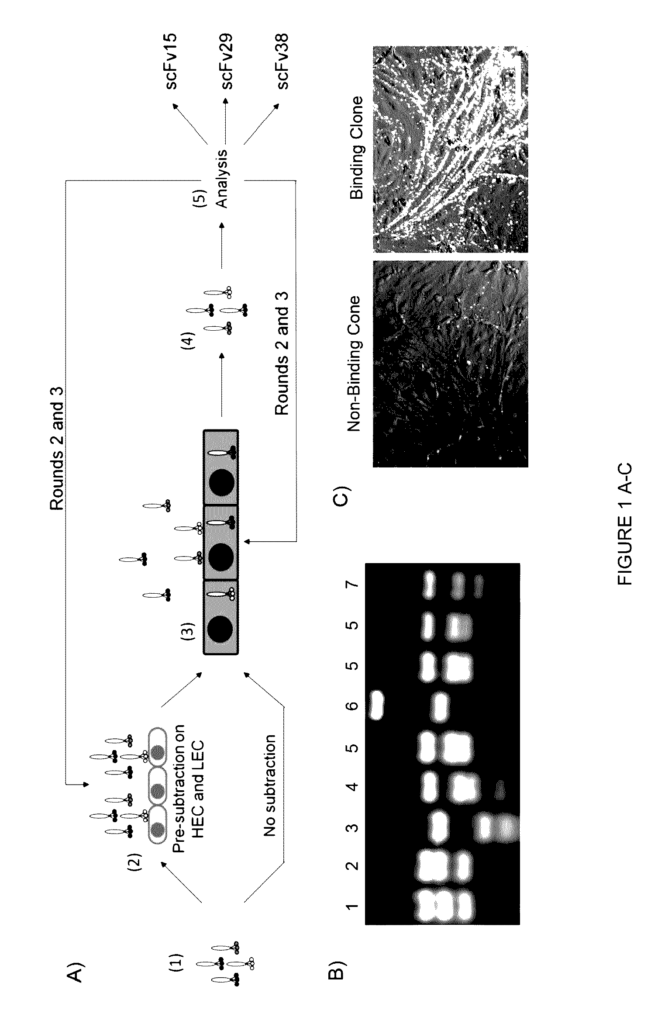
The Wisconsin Alumni Research Foundation invention works as follows
This application discloses BBB-selective antibodies. The BBB selective antibody is encoded by either a DNA-sequence containing SEQ NO.7 (CDRH1 scFv 15, SEQ NO.8 (CDRH2 scFv 15, SEQ NO.9 (CDRH3 scFv15), or SEQ NO.19 (CDRH1 scFv38), SEQ NO.20 (CDRH2 scFv38),SEQ NO.21 (CDRH3 The BBB-selective antibodies are preferably encoded by either SEQ ID No:1 or 3.
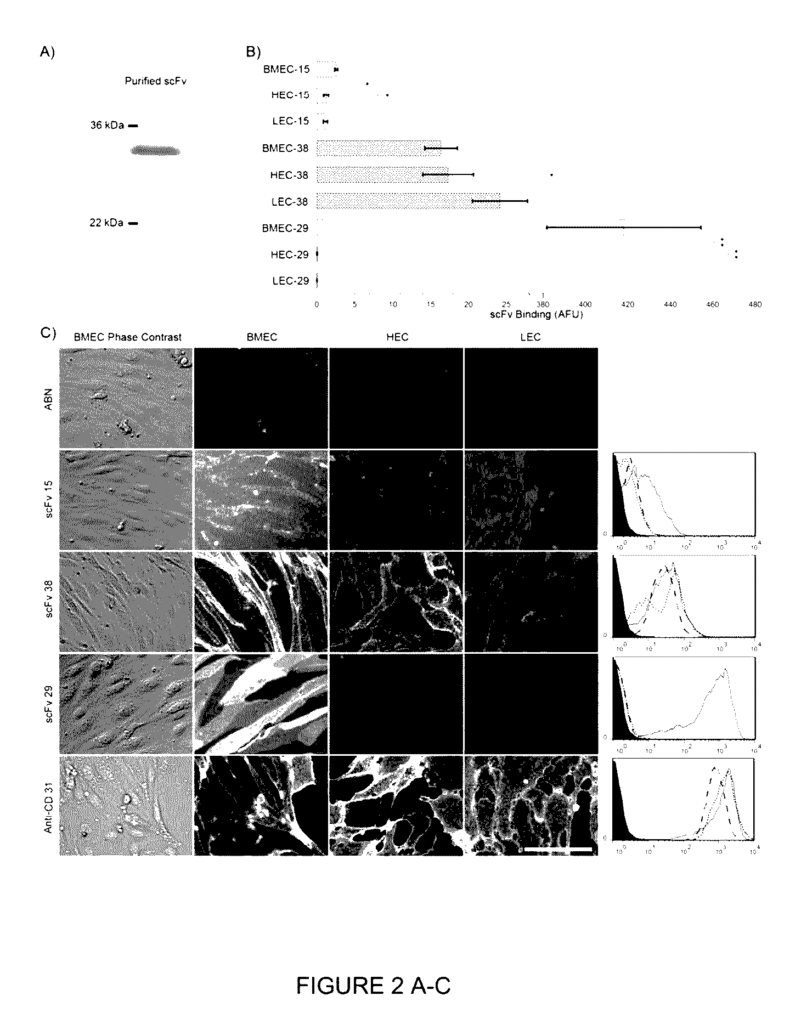
Background for Blood-brain barrier antibodies
The vascular network in the brain is a biological barrier called the blood-brain (BBB). The BBB has a unique vascular pattern that is induced in neighboring cells, such as pericytes and astrocytes, that together form the Neurovascular Unit (Abbott N. J., and A. Friedman Overview and Introduction: The Blood-Brain Barrier in Health and Disease). Epilepsia, 2012. 53: p. 1-6). This phenotype can be described as a combination properties that are designed to maintain homeostasis in the brain, such as tight paracellular junctions and a large transporter repertoire. It also has a low level of basal pinocytosis. These characteristics make the BBB permeable only to the required ions and nutrients, or cells. Curr. Pharm. Des. 2013). The BBB is important for maintaining the neuronal environment in the brain, but it also blocks most therapeutics (Jones A. R. & Shusta E.V., Blood-brain barriers transport of therapeutics by receptor-mediated; Pharm. Res., 2007. 24(9): p. 1759-1771). The BBB is a major obstacle to the treatment for central nervous system diseases, and effective delivery methods remain scarce.
The BBB is a barrier that prevents drugs from entering the brain. One promising method of delivery involves using antibodies to target known receptor-mediated transport system. This approach is exemplified by antibodies that target insulin and transferrin receptors. Res., 1994. 11(5): p.738-746. Pardridge, W. M. Y. S. Kang J. L. Buciak and J. Yang Human Insulin Receptor Monoclonal antibody Undergoes Rapid Transcytosis through the Blood-Brain Barrier In vivo. Pharm. Res., 1995. 12(6): p. 807-816). These systems are able to allow therapeutic doses of drugs to penetrate the BBB but they are non-selective by nature and inefficient. Current brain drug delivery systems are not efficient and select. This has led to the search for new antibody-based brain drug delivery targets. Curr. Pharm. Des. 2013).
Antibody-based screening has proven to be a useful tool in addressing this problem. These screens were used to identify BBB surface proteins which can mediate targeting of the brain and in some cases transport. In vitro and in vivo, large combinatorial antibodies libraries were screened in different formats against brain endothelial cellular types to identify both the antibody targeting molecules as well as cognate brain cell proteins. The identified antibody-BBB-antigen pairs appear promising in terms of circumventing BBB. However, only a few new antibodies were isolated. 15(14): p. 240). Multiple genomic and proteomic analyses support significant differences in gene transcription between the peripheral and brain microvascular endothelium, especially in areas of signaling and transport between the bloodstream and brain (Li, J. Y. Blood Flow Metab. 2001. 21(1): p. 61 – 68; Calabria A. R., and E. V. Shusta Blood-Brain Barrier Genomics, and Proteomics : Elucidating Phenotypes, Identifying disease targets, and Enabling brain drug delivery, Drug Discovery. Today, 2006. Today, 2006. PLoS One. 5(10)).
The art requires an improved BBB selective antibody.
In one embodiment, the present invention is an antibody that selects BBB, and preferably contains a protein encoded with SEQ ID No:1 or 3. In another embodiment, the antibody contains a peptide that is encoded by SEQ ID No:1 (CDR H1, SEQ ID No:2, SEQ NO:3, CDRH1, CDRH2, SEQ NO:3, CDRL1, SEQ NO:2, or SEQ NO:3 CDRL1, or CDRL2 of SEQ NO:3) or SEQ NO:3 (CDR H1, SEQ NO:2, SEQ NO:3, CDRH1, CDRH2, CDRH3, CDRL1,
In another embodiment, the BBB-selective antibody is connected to a compound, preferably a pharmaceutical or therapeutic compound. In another embodiment, a BBB-selective antigen is attached to a compound. Preferably, this compound will be a pharmaceutical or therapeutic agent.
In another embodiment of the invention, a BBB selective antibody is used in a vector. In another embodiment, a microorganism containing the vector is the invention. “In another embodiment, the invention comprises a method for targeting a therapeutic or pharmaceutical compound to the blood-brain barrier of a patient comprising the steps obtaining a BBB selective antibody attached to the pharmaceutical or therapeutic compounds and exposing that antibody to the subject’s brain.
DESCRIPTION of Drawings
This patent application contains at least one color drawing. The Office will provide copies of this patent publication or patent application with color drawings upon request and payment.
FIG. The 1 (A-C), reveals the antibody library screening using an in vitro BBB. A) Step 1. Displaying a library human scFv using fd-tet. Step 2: In an effort to improve brain specificity, one path used pre-subtraction methods using endothelial cells from rat lungs (LEC), rat hearts (HEC), and rat spleens (LEC). The parallel screening pathway did not use library subtraction. Step 3: Incubation of library with BMECs in order to allow binding and internalization by the antibody-bearing phage. After incubation the BMECs are washed and stripped. Step 4: Lysing the BMECs to recover any phages that are still bound with the cells due to internalization or stripping resistance. Step 5: Library pool analyses were performed on a clonal level by phage titer and BstNI mapping. In the final rounds phage immunocytochemistry was also carried out. B) Sample BstN1 digestion pattern on an agarose gel. The patterns are grouped by number in order to show the clustering that was used to calculate the statistics shown in Table 1. C) Images from clonal immunocytochemistry with BMECs, to determine which clones showed a binding phenotype. The image on the left shows a nonbinding clone and the image on the right shows scFv38 as a phage. The scale bar is 50?m.
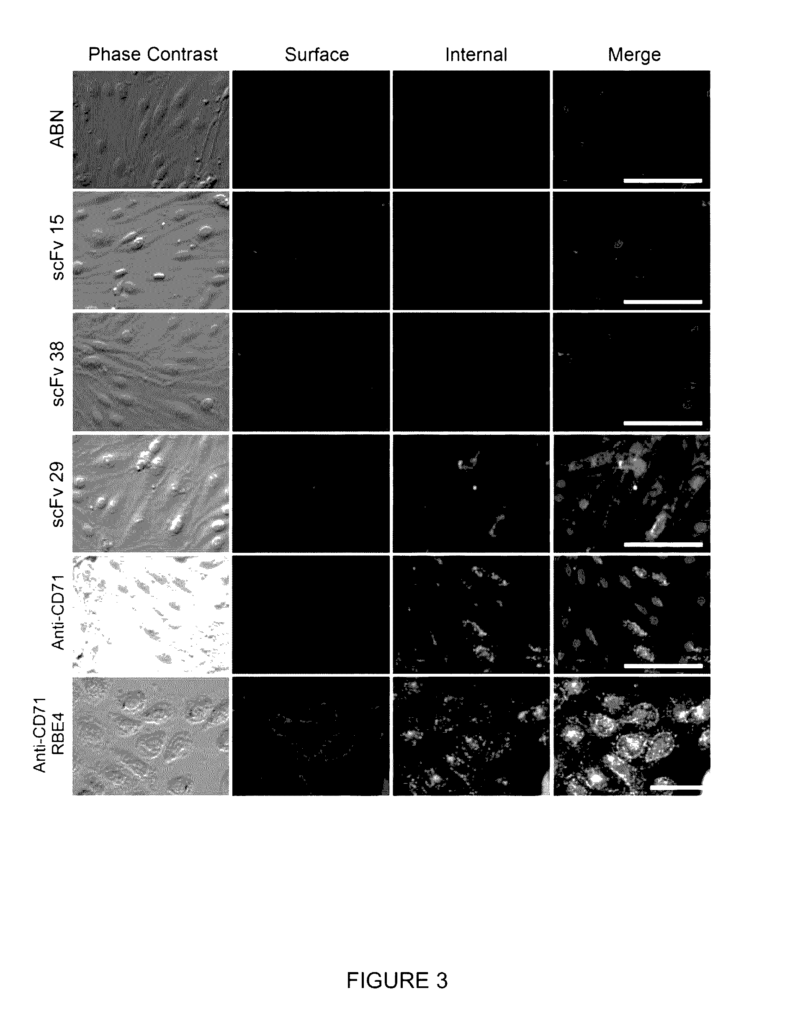
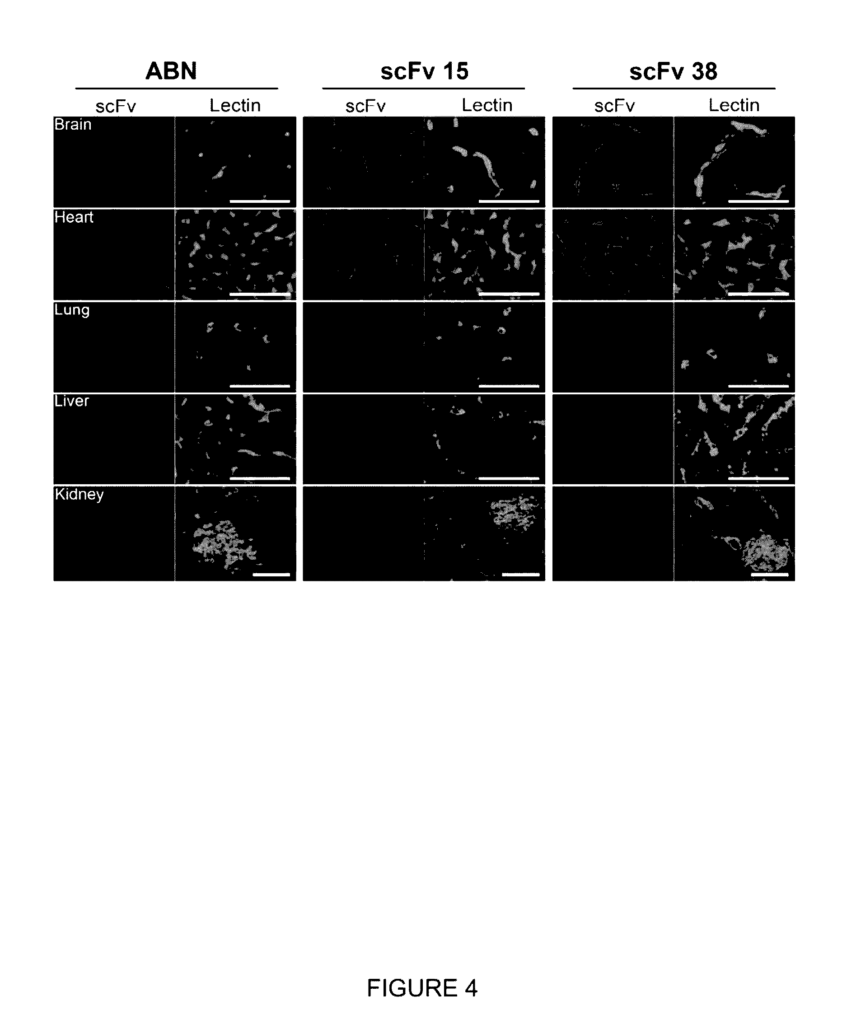
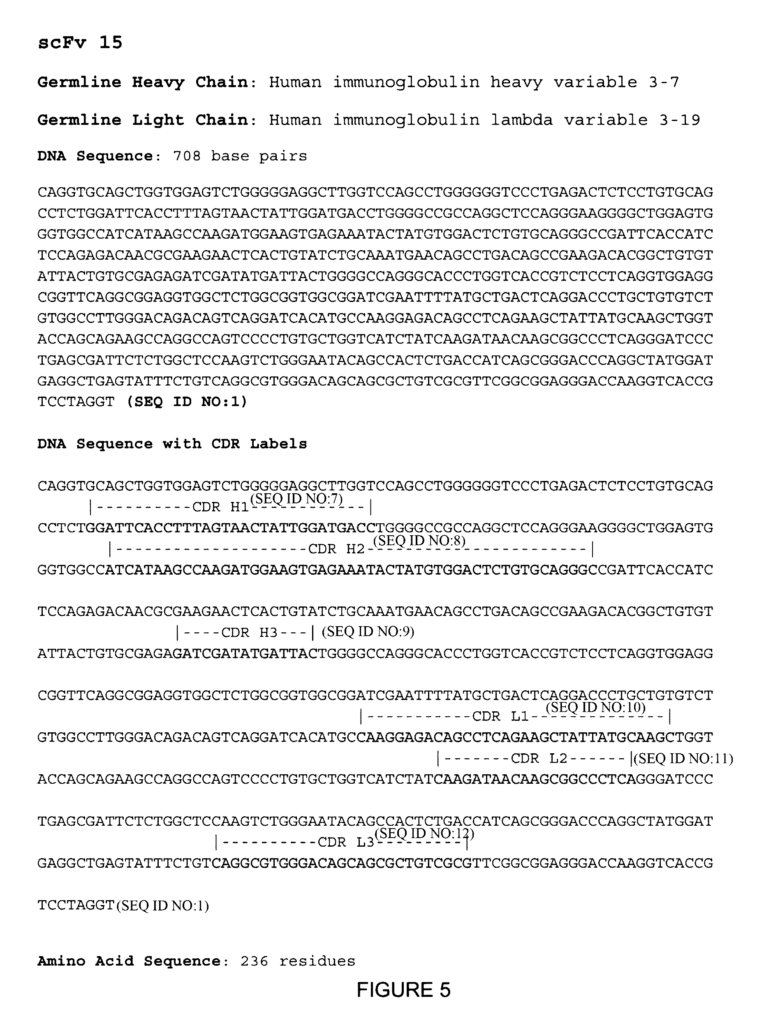
FIG. The distribution of the antibody binding in tissue is shown on Figure 4. Purified ABN-scFv, scFv15 and scFv38, were incubated at 100 g/mL (3 M), except for kidney, which was labeled at 50 g/mL (1?M), to reduce nonspecific background. These concentrations produced a clearly visible labeling of brain vasculature. The sections were labeled serially with anti-rat CD31 antibodies and FITC conjugated IB4 lectin, as endothelial cells markers. The scale bar is equal to 50?m.
FIG. “FIG.
DESCRIPTION THE INVENTION
In General
As discussed above, in brief, the BBB is a barrier to targeting and delivering therapies to the central nervous systems. To discover new BBB-targeting molecules, we panned a non-immune single-chain human antibody fragment (scFv), displaying phages against a BBB model consisting of hydrocortisone-treated primary rat brain cells endothelial to obtain antibodies fragments that target BBB. In the examples below, parallel screens with or without presubtraction were performed against primary rat lung and heart endothelial cell in an attempt to identify antibodies which may have binding specificity towards brain endothelial-cells.
After three rounds of screening we identified three unique (scFv15 scFv38 and scFv29 scFv) scFvs that retained binding to primary rat rat brain endothelial cell, both in the phage format and soluble scFv. In tissue culture, both scFv29, and to a lesser degree, scFv15 showed brain endothelial cells selectivity, but scFv29 didn’t appear to bind BBB antigens in vivo. Both scFv15 & scFv38 showed significant brain vascular specificity in their binding to rat vessels in vivo, as determined by differential vascular immuno-labeling of tissue sections. The scFv15 and scFv38 antibodies (SEQID NOS:1 & 2) are two new antibodies capable of binding BBB antigens in vivo.
BBB Selective Antibodies Of The Present Invention
In one embodiment, an antibody that can selectively target the BBB is the invention. “Selectively” means that the antibody is capable of binding to the surface of brain vessels but does not bind to lung, liver or kidney tissue vasculature. By?selectively?, we mean that the antibody can bind to the surface vasculature of the brain but not to that of the liver, kidney, or lung tissue. Binding means that antibodies can be detected at the endothelium of a tissue using standard methods. tissue section immunofluorescence assays.) By “antibody” we mean single chain antibodies, such as scFv15 and scFv38, and antibody fragments, such as the CDR segments within a corresponding. By?antibody?, we mean single-chain antibodies such as scFv15 or scFv38 and antibody fragments such as CDR segments in scFv15 or scFv38.
In a single exemplary embodiment of the invention, it is a BBB selective antibody containing a sequence shown in FIG. 5. The invention could be an expression vector containing a polynucleotide that encodes scFv15, scFv38 or any other degenerate tricodons that produce the same amino acid. In other embodiments the nucleotide sequence or protein sequence includes conservative or inconsequential deletions or substitutions. In other embodiments the BBB-selective antibodies is at least one sequence of the CDR (complementarity determining regions) shown in FIG. 5. Figure 5 shows the CDRs in SEQ ID NOs: 1 and 3″ Note that FIG.
Click here to view the patent on Google Patents.
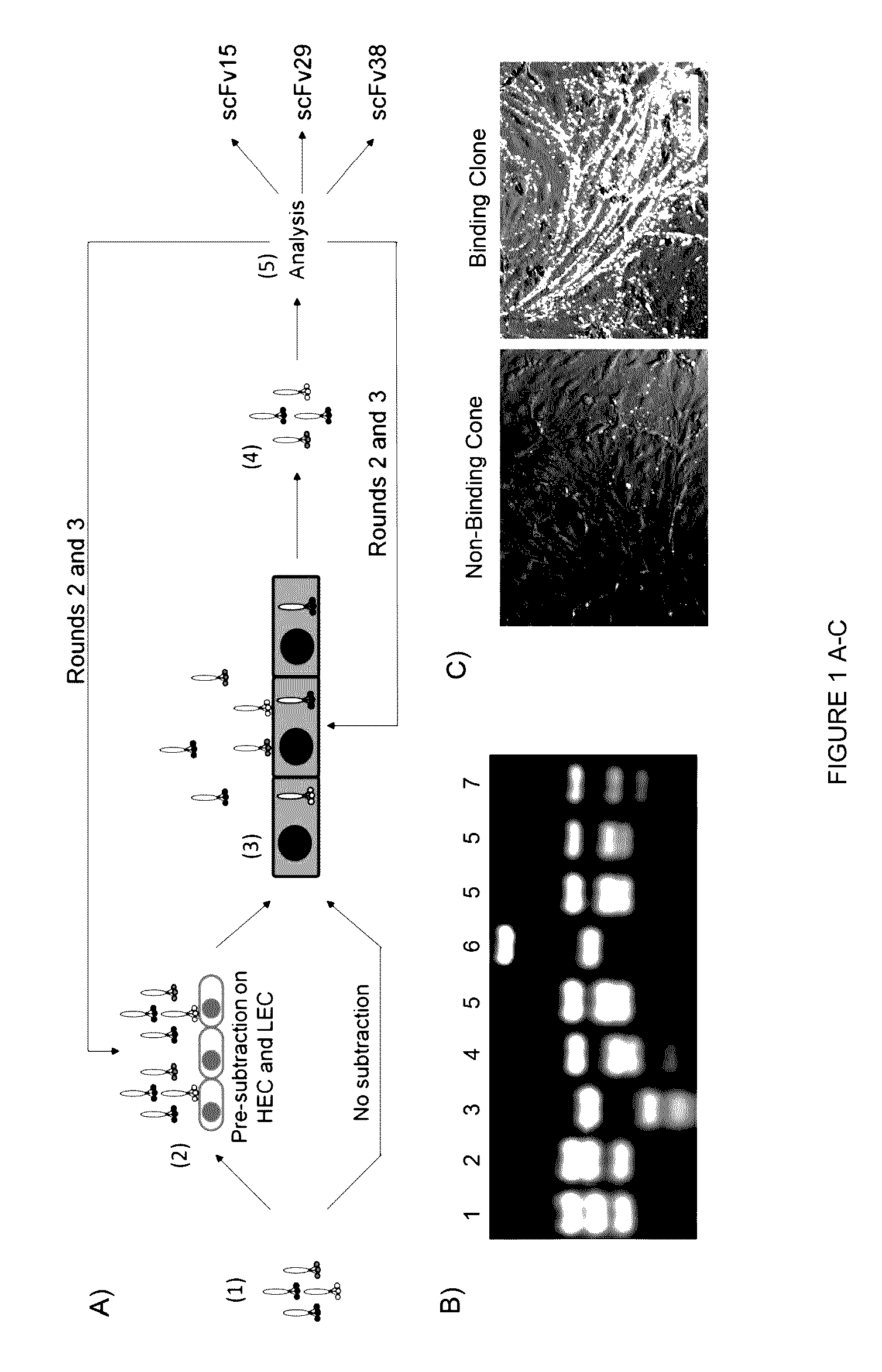
Leave a Reply